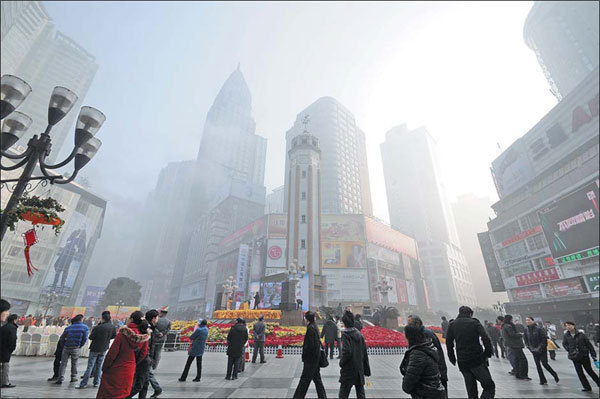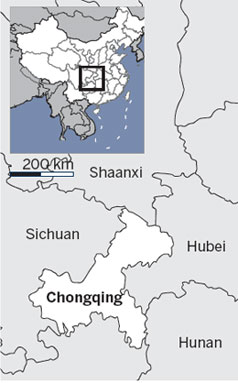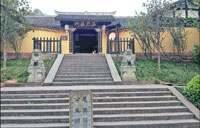History Echoes in metropolis
 |
|
Thick fog adds charm to the square where Liberation Monument stands. Zhong Guilin / For China Daily |
With a population of 30 million, Chongqing may just be the biggest city in the world, making it a perfect place for people watching and experiencing the sights, sounds and tastes of modern China. Raymond Zhou reports.
Chongqing has the population of some European countries. At 30 million, it could be the largest city in the world. Granted, much of it remains rural, but the rate of urbanization is so fast the metro ride from the airport shows an unbroken stretch of new housing projects. To study its people, without the benefit of touring the sprawling city, one can go to one of the hot spots where people congregate. I'm suggesting three here, but there are many more throughout the city.
The number one choice is Liberation Monument, or rather, the plaza where it stands. If you do not come here, your visit to Chongqing is incomplete, or so the saying goes. It is the equivalent of Times Square in New York, surrounded by flashy neon signs and giant billboards and name-brand retailers.
According to one magazine, you'll see a higher concentration of beautiful women in this 24,400-square-meter plaza than anywhere else in China. They actually sent people counting and came back with a figure, which, unfortunately, I'm unable to locate right now.
Suffice to say, Liberation Monument has its share of tourists. But you can generally tell them apart from the locals. The monument can be photographed from all sides - you'll have to take a picture to prove you've been here - but a little history lesson can spruce up your tale.
There used to be a wooden obelisk, which was bombed by the Japanese. Actually, not far from here is the tunnel where some thousand were suffocated to death during one of the bombing raids.
There were a total of 9,166 Japanese sorties against Chongqing, resulting in the deaths of 24,000 people and the destruction of 17,452 buildings in the city during the War of Resistance against Japanese Aggression (1937-45).
A monument was erected in 1947 to commemorate the victory against Japanese invasion and it was renamed from Victory Monument to Liberation Monument with the founding of New China two years later.
Before the days of planes and trains, visitors would arrive at Chaotianmen, or the Gate That Faces Heaven. It was at the tip of the estuary where the Jialing River empties into the Yangtze River, somewhat like New York's Battery Park and Ellis Island joined as one.
The wharf has been here for almost a century, (the original city gate it replaced can be traced back to 314 BC) but the 50,000-square-meter plaza was built in 1998.
Watched from an incoming vessel, it resembles a majestic bow, with the multi-level as the deck and the skyscrapers in the background as sails.
|
|
On a recent visit, the neighboring streets are being razed and a new bridge is under construction across the Jialing River. I almost feel nostalgic for the time when people departed from and arrived in the city at this junction. It must have been a different kind of hustle and bustle. Because the plaza is spacious and features several levels, people run around flying kites, and youths figure-skate along its riverside stairs - an acrobatic feat.
Back to people watching. I sense that many of the visitors here are from rural Chongqing. For one thing, it is a hub from inter-municipality traffic. In that sense, a snapshot here may give you a cross-section of China's fourth province-level municipality.















